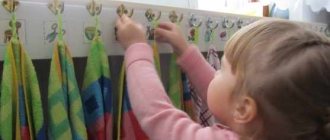Preschool children show special interest in the surrounding nature, its elements and phenomena. Home lessons on the topic “Seasons” should teach the child to distinguish the characteristic signs of spring, summer, autumn, and winter. It would be good if classes were based on joint observations and visual reinforcement of the material.
Spring changes
Spring is a time of year similar to early morning. Nature awakens from winter sleep. The sun's rays begin to warm the frozen ground. Everything around comes to life, filling the air with cheerful sounds.
The last frosts are still making themselves felt, but we can already note the three first signs of the coming spring:
| Sign | Description |
| Snow melting | The days are getting a little warmer and the snow lying on the roadsides is beginning to settle. Its top layer hardens, forming dense ice. Melted snow takes on a grayish tint and gradually turns into streams. |
| The sound of drops | At the same time as the snowdrifts, the icicles begin to thaw. Droplets of water falling from the roofs ring, breaking on the asphalt and forming numerous puddles. |
| Weather variability | In early spring the weather changes frequently. Winter is in no hurry to retreat; you can often see snow or rain outside the window. Frosts are possible. However, the sun appears more and more often, and the cold is replaced by warmer days. Gradually there are more and more of them. |
Spring transformation in different cultures
Nature in spring is not only about dramatic changes in the surrounding nature, but also a great holiday for the Slavs. March 22 is listed in the folk calendar as Lark Day. It is believed that it is on this date that the first 40 birds arrive every year, bringing spring on their wings. Believers hoped that their hooting on this day would attract warmth and a rich harvest. But March 22 is only the second or subsequent date for attracting spring; they often started hooting when spring itself spoke about it, the drops began, and the snow melted profusely.
For the Japanese, the blossoming nature in spring is its awakening, as for all peoples of the world. Setsubun-sai is a Shinto holiday that marks the end of the long winter season and the beginning of the long-awaited spring.
In medieval Britain, spring was celebrated on the first Monday in May. On the day of the celebration, the girls washed themselves with dew, and the boys competed in archery. But not all Englishmen celebrate it, because it was on the day of the spring celebration that Robin Hood was arrested.
In any case, spring is a time of change, when the soul awakens, new sensations appear, and there is nothing more magnificent than the riot of colors of nature.
Changes in wildlife
Plants, animals, birds, and insects rejoice at the beginning of spring. It is interesting to observe how representatives of wildlife react to spring changes.
Plants
Under the influence of solar heat and light, the entire plant world begins to awaken. The soil becomes warm and moist - these are favorable conditions for plant development. Nutrients accumulated in the roots move to the “tops”.
At this time, the following processes are observed:
- appearance of early grass;
- germination of primroses (snowdrops);
- swelling of buds on trees and shrubs;
- punching green leaves;
- flowering plants.
Animals
With the onset of spring, wild animals begin to show increased activity. This is due to warming temperatures and the discovery of sufficient food in the forest environment.
The spring period of life of four-legged animals is characterized by the following phenomena:
- awakening hibernating animals (bears, badgers, hedgehogs);
- the birth of young (hares, squirrels, foxes, wolf cubs) and feeding them with milk;
- active acquisition of “adult” food: grass, young shoots, tree bark, insects;
- molting - a change from thick winter wool to a thinner one, in some animals (such as a hare, squirrel, arctic fox, ermine, weasel) is accompanied by a change in color;
- in horned representatives (elk, roe deer) - the growth of a new pair of antlers.
Birds
Significant changes can also be observed in the environment of birds:
- return of migratory birds (rooks, starlings, larks, lapwings, swallows, cuckoos, swifts, storks);
- nest construction;
- hatching eggs and feeding chicks;
- change of plumage in some varieties (for example, in partridges the white feather cover is replaced by brown-gray);
- joyful birdsong from early morning until the evening.
Insects
With the arrival of spring warmth, the first insects appear. Flies, mosquitoes, and butterflies wake up before everyone else. Soon you will notice bees and bumblebees collecting sweet nectar from young flowers. At the height of the season, ladybugs appear, ready to protect plants from harmful insects. When it gets really warm, you can see real cockchafers in parks and squares.
Characteristic signs of the onset of natural spring phenomena
The season of spring in the world around us is a mysterious and exciting event, since it occurs with such characteristic signs of rapidly changing natural phenomena as:
- Abundant melting of snow - when spring daylight hours noticeably lengthen, and the bright sun, rising high above the horizon, tries to shine longer, giving off more and more of the day's tangible heat. Under the influence of these intense processes, the deep, frozen snow that has accumulated over the winter begins to actively melt.
- Formation of icicles - the slow melting of snow forms spring drops, which on a warm day flow down drop by drop from numerous roofs of houses. In the evening, when the sun goes below the horizon, the air temperature cools sharply and the flowing drops instantly freeze.
- The appearance of thawed patches - under the influence of the heat of the daytime rays of the bright sun, dark areas of wet earth melted from snow appear in the open spaces of the hills, standing out sharply against the snow-white background of the winter landscape.
- Ice drift on the river - under the influence of the scorching spring sun, warm wind and continuous water flow, the ice fields become thinner and gradually burst, setting in motion huge masses of slowly melting ice floes.
- Uncontrollable flood is a prolonged influx of numerous streams of water into deep rivers with flooding of nearby floodplains. Due to the abundant melting of snow, the water regime quickly changes and the water level instantly rises, accompanied by the river overflowing its banks.
All these five signs of the onset of spring in inanimate nature are the main seasonal phenomena. In living nature, there are spring phenomena that are unique to it -
- early flowering of plants and the movement of juices in them from the roots to the top,
- swelling of buds, blossoming of leaves and appearance of flowers,
- the arrival of migratory birds and the polyphonic singing of birds,
- awakening of animals from hibernation and shedding of fur,
- the birth of animals and the birth of young chicks,
- feeding offspring of birds and raising the younger generation of animals,
which, of course, are associated with weather and annual seasonal warming of the climate, which promises heavy rainfall, subsequently changing the living conditions of numerous flora and fauna.
At this spring time, the following appear more and more often:
- morning fogs and light drizzles,
- dangerous hail precipitation and May thunderstorms,
- a squally wind sharply changing its strength and direction and the arrival of persistent heat.
These are the many signs of the onset of real spring.
Spring in pictures
To consolidate the knowledge the child has acquired, it is worth using illustrations on the topic “What spring it is!”
Available materials can include:
- thematic drawings;
- cut pictures;
- cards with images on the topic.
Illustrations may show:
- spring flowers;
- migratory birds;
- insects;
- Stories from the life of animals in the spring.
You can invite your child to draw spring as he imagines it, and then discuss the details of the drawing with him. It would be appropriate to learn several short poems on the topic with your child, and then select suitable images for them. You can make illustrations in the form of appliqués yourself using cut-out pictures. It’s good to prepare riddles about spring in advance along with the answers shown on small cards.
Children's cognitive abilities are maximized when using visual materials, especially if a serious lesson is taught in a light playful way.
Interesting Facts
Nature in spring is surrounded by numerous myths and interesting facts.
If we talk about people living near the North Pole, then in the spring they will definitely notice the sun sliding across the horizon in the sky. This is confirmation that the six months of the polar day are coming. And at the South Pole, this phenomenon indicates that 6 months of polar night are approaching. It is at the South Pole that spring occurs from September to November.
The spring equinox, observed in our country on March 20-21, means the period when the day begins to become longer than the night.
The Egyptian Sphinx was positioned by the ancient Egyptians in such a way that it clearly indicates the sunrise on the day of the vernal equinox. And the ancient Greeks believed that the first day of spring is the day when the goddess of fertility Persephone returns after a long stay in the underworld.
In America, Groundhog Day is still celebrated to this day. Every year on February 2 in the city of Punxsutawney, a groundhog is pulled out of its hole, which by default has the name “Phil.” If he suddenly sees his shadow, it means that winter still has 6 weeks to “rule”. If the groundhog doesn’t see her, doesn’t get scared and doesn’t hide in a hole, then spring has already come.
Autumn natural phenomena
With the arrival of autumn, it becomes cooler outside, the leaves gradually turn yellow and fall off, migratory birds head off to warmer climes, and insects and amphibians hide from view.
Leaf fall
All plants and trees have their own year-round life cycle. Before winter, trees always shed their leaves, and first they turn yellow.
Why does a tree need to get rid of its leaves? So that the snow that falls does not break the branches. Before the leaves begin to fall, the leaves on the trees dry out, turn yellow or red, and then the wind begins to blow them down. This phenomenon is called leaf fall.
Autumn: Freepick
Fogs
In autumn, during the day the earth and water still heat up, but in the evening it gets colder and fogs appear. If the air humidity is high, for example after rains, which often occur in the fall, the air forms tiny droplets of water as it cools. They float above the ground, and people perceive them as fog.
Dew
This name was given by people to the droplets of water that fall on the grass and leaves in the morning. At night, the air cools down, and the water vapor that was in it settles in the form of droplets on the surface of the earth, grass and tree leaves. This is how dew is formed. If it is very cold at night, up to frost, then in the fall you can see frost - small crystals of water on tree branches and grass.
Showers and winds
In autumn there are often heavy torrential rains with gusts of wind. At this time of year there is a lot of water vapor in the air. It supercools and forms clouds containing small ice crystals.
At low air temperatures (below zero degrees) they grow and become heavier. At the bottom of the cloud, the crystals thaw and fall to the surface of the earth like raindrops.
Summer natural phenomena
In summer everything around turns green and blooms. Rivers and other bodies of water warm up so that you can swim in them. The sun is heating up with all its might, there are very hot days. During the summer, the days are the longest and the nights are very short. At this time, many fruits and vegetables ripen and are harvested at the end of August. We recognize summer by a number of signs.
Heat
In the summer, during the day, the sun's rays fall vertically onto the Earth and intensely heat its surface. At night, this heat is transferred back into the atmosphere. That is why in summer it is so hot at any time of the day.
Showers with thunderstorms
In summer the rains are usually warm, sudden and short-lived. Summer rains are often accompanied by thunderstorms. It also happens that during rain the sun continues to shine. Such precipitation is called mushroom rain.
The fact is that rain in summer can come from a very small cloud, which does not happen at other times. Light rain is called drizzle.
Summer: Freepick
Rainbow
After heavy rains and downpours with thunderstorms in the summer, increased humidity is observed in the atmosphere and such a phenomenon as a rainbow is observed. The observer sees this optical miracle as a multi-colored arc.
When the sun's rays refract water droplets, optical distortion occurs. From white, all other colors are formed and become visible and form a bright colorful arc in the sky.
Winter natural phenomena
Winter: Freepick
In winter, it gets really cold outside, frost starts, everyone is waiting for the snow to fall. Rivers and lakes are frozen. In winter, the nights are very long and the days are very short. It gets dark early, and the sunlight does not provide warmth. At this time of year, a number of phenomena occur in nature.
frosts
The temperature in winter drops below zero, and therefore the water in the environment freezes. After a sharp cold snap, icicles appear on the roofs of houses, and roads are covered with a layer of ice, which is called glaze.
In the event of a temperature difference, the windows on the outside are decorated with frosty patterns. Water droplets from the air freeze so beautifully.
Freeze-up
In winter, a layer of ice forms on the surface of reservoirs, that is, freeze-up. Ice usually persists until spring, when warming begins, ice drift and the next natural cycle begin.
Snowfalls
The cooled water in the clouds turns into snow and falls to the ground in this form, covering it with a white blanket. Due to the low temperature, the snow does not melt and forms high snowdrifts.
Blizzards
This is the name given to snowfalls with strong winds. The wind is such that it knocks you off your feet. It gets very cold and dark. A person who finds himself outside in a snowstorm runs the risk of hypothermia.
Nature is very diverse and always beautiful. Seasons change each other - spring, summer, autumn and winter. Each of them brings its own wonders of natural phenomena, which you can and should enjoy, because, as you know, nature does not have bad weather.
Original article: https://www.nur.kz/family/school/1909299-yavleniya-prirody-po-vremenam-goda/






